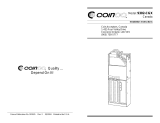
8Part # 8533-065-001 4/20
3. MAKE-UP AIR. Adequate make-up air (830 CFM) must be supplied to replace air exhausted by dryers
on all types of installations. Provide a minimum of one square foot make-up air opening to the outside for
each dryer. This is a net requirement of eective area. Screens, grills or louvers which will restrict the ow
of air must be considered. Consult the supplier to determine the free area equivalent for the grill being
used.
The source of make-up air should be located suciently away from the dryers to allow an even airow to
the air intakes of all dryers. Multiple openings should be provided.
NOTE: The following considerations must be observed for gas dryer installations where
dry cleaners are installed. The sources of all make-up air and room ventilation air move-
ment to all dryers must be located away from any dry cleaners. This is necessary so that
solvent vapors will not be drawn into the dryer inlet ducts. Dry cleaner solvent vapors will
decompose in contact with an open ame such as the gas ame present in clothes dryers.
The decomposition products are highly corrosive and will cause damage to the dryer(s),
ducts and clothes loads.
4. ELECTRICAL REQUIREMENTS. The electrical power reqUirements necessary to operate the unit sat-
isfactorily are listed on the serial plate located on the back panel of each dryer. The electrical connection
should be made to the pig tail leads in the outlet box (or terminal board, if supplied) on the rear of the unit,
using a wire size adequate to handle the amperage and voltage listed on the serial plate, but never smaller
than NO.12 AWGwire. It is absolutely necessary that the dryer be grounded to a known ground.
Individual circuit breakers for each unit are recommended. The wiring diagram is located on the belt guard
on the back of the machine.
5. GAS REQUIREMENTS. The complete gas reqUirements necessary to operate the dryer satisfactorily
are listed on the serial plate located on the back panel of the dryer.
• The inlet gas connection to the unit is 1/2 inch pipe thread. A joint compound resistant to the action of
liqueed petroleum gases should be employed in making pipe connections.
• An 1/8 inch NPT plugged tapping, accessible for test gage connection, must be installed immediately
upstream of the gas supply connection to the dryer.
• A drip tee should be provided in the gas piping entering the unit to catch dirt and other foreign articles.
• All pipe connections should be checked for leakage with soap solution. Never check with an open
ame. For altitudes above 2,000 feet (610m) it is necessary to derate the BTU input. Contact your lo-
cal distributor for instructions.
• L.P. gas conversion kits are available for this dryer. Contact your local distributor.
CAUTION: The dryer and its individual shuto valve must be disconnected from the gas supply piping
system during any pressure testing of that system at test pressures in excess of 1/2 psig. The dryer must
be isolated from the gas supply piping system by closing its individual manual shuto valve during any
pressure testing of the gas supply piping system at test pressures equal to or less than 1/2 psig.
6. EXHAUST INSTALLATION. (Refer to Figure 2 at the end of section 6.) EXhausting of the dryer(s)
should be planned and constructed so that no air restrictions occur. Any restriction due to pipe size or
type of installation can cause slow drying time, excessive heat, and lint in the room. From an operational
standpoint, incorrect or inadequate exhausting can cause a cycling ofthe high Iimitthermostat which shuts
o the main burners and results in inecient drying.
Individual exhausting of the dryers is recommended. All heat, moisture, and lint should be exhausted
outside by attaching a pipe of the proper diameter to the dryer adapter collar and extending it out through
an outside wall. This pipe must be very smooth on the inside, as rough surfaces tend to collect lint which
will eventually clog the duct and prevent the dryer from exhausting properly. All elbows must be smooth on
the inside. All joints must be made so the exhaust end of one pipe is inside the next one downstream. The
addition of an exhaust pipe tends to reduce the amount of air the blower can exhaust. This does not aect
the dryer operation if held within practical limits. For the most ecient operation, it is recommended that
no more than 20 feet (8m) of straight 8" diameter pipe be used with two right angle elbows. When more























